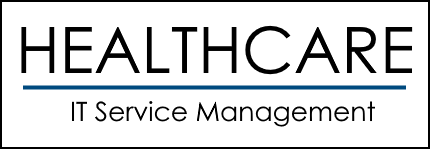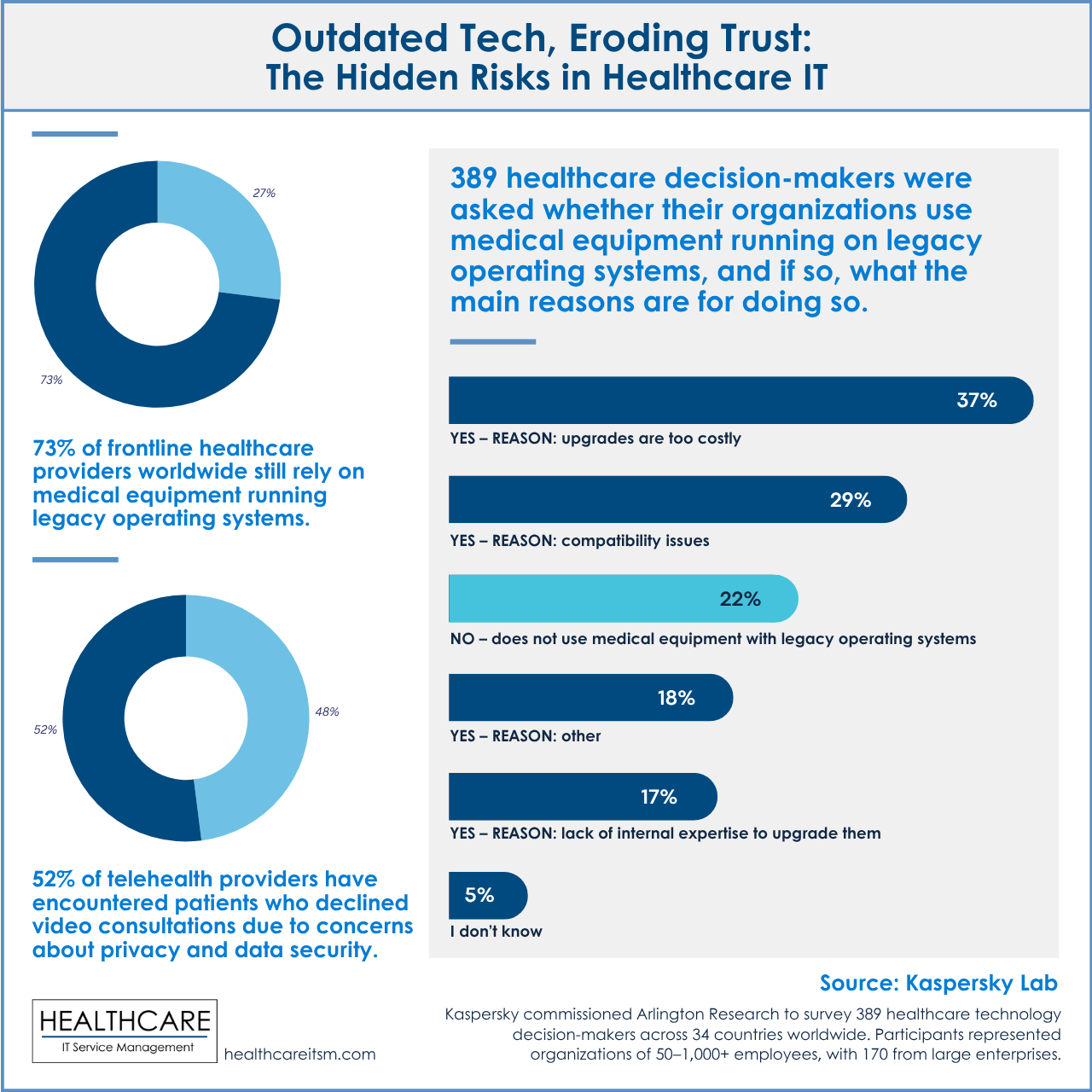Table of Contents
ToggleOutdated hospital IT infrastructure is a quiet obstacle that can prevent medical facilities from peak performance. It can compromise the institution’s security, create compliance issues, incur ongoing costs, and impact patient care.
In a 2021 global report by Kapersky, over 73% of hospitals worldwide operated on outdated IT legacy infrastructure (Kapersky, 2021). Legacy IT infrastructure often fails to incorporate modern cybersecurity measures, exposing systems to increasingly sophisticated cyberattacks. In addition to these risks, as technologies update, regulations follow. Oftentimes, outdated systems fall short of meeting compliance, leading to costly updates later on that can interrupt critical hospital operations.
Many billing systems and EHRs are becoming increasingly reliant on cloud-based systems and other contemporary technologies. The longer legacy IT systems remain outdated, the more attrition can occur when necessary updates are required to meet modern demands. Ultimately, such deficiencies can affect patients. Delays in receiving critical data, bottlenecks in workflows, and overall confusion can hinder a patient’s access to the care they need.
Legacy Systems and Technical Debt
Ultimately, the cost of maintaining legacy IT systems outweighs the short-term benefits that they may provide. Although keeping older systems may seem more economical, ultimately, they are more expensive to maintain, lack compatibility with modern solutions, and lead to vendor lock-in.
It may be worth exploring other solutions to help mitigate these costs.
 Maintenance Costs
Maintenance Costs
Many institutions are unaware of the high cost of maintaining legacy healthcare systems. Outdated IT infrastructure is typically less efficient, consumes higher resources, and is slower. A study by Mechanical Orchard found that institutions using legacy IT systems spend approximately 60-80% of their IT budget on simply maintaining them (Rachit Awasthi, 2023).
 Hospital Tech-Debt
Hospital Tech-Debt
Occasionally, locking into a system that trades speed for compatibility can seem like an economic decision. However, with the development of EHRs, the introduction of AI tools, and an increasing need for mobile access, hospitals may find themselves in a situation where the cost of updating to newer systems is increasingly steep. This can compound over time and lead to avoidable problems.
 Vendor Lock-In
Vendor Lock-In
As costs for necessary updates accrue, hospitals may find themselves in a dangerous situation, relying on outdated hardware and subjecting themselves to vendor lock-in. This brings the additional problem of being reliant on a small number of tech providers. If there is an end to service, increased costs, or a lapse in support, legacy IT systems will inevitably run into problems.

Fragmented Platforms and Data Silos
Contemporary IT systems are increasingly moving towards a model of consolidation. Cloud-based systems, EHRs, and mobile access all require up-to-date information across a variety of platforms. However, many legacy IT systems rely on independent databases that need to constantly communicate with each other.
This creates a fragmented healthcare IT system, which can lead to critical inefficiencies, risks to patients, and redundant labor across departments.
 Disconnected Systems and Workflow Miscommunication
Disconnected Systems and Workflow Miscommunication
Fragmented data leads to what are known as “data silos.” This is stored data that stands essentially sealed from outside systems. When critical updates are made to a patient’s data in one department, for example, they may not be made in another. This can create miscommunications across departments and inefficiencies that cause unnecessary confusion.
 Risks to Patient Safety and Decision Making
Risks to Patient Safety and Decision Making
Data silos can lead to serious errors, particularly when it comes to a patient’s information. Should one department provide incomplete information to a doctor, there is a real risk of misdiagnosis or medication errors, as well as paralysis in decision-making when caregivers lack information.
Independent data systems are also vulnerable to breaches that can compromise a patient’s information. According to a recent MindIt Systems article (Sujoy Roy, 2025), 74% of hospitals using legacy IT infrastructure experienced at least one cybersecurity breach in that year. In the digital landscape, maintaining robust cybersecurity is crucial, as serious breaches can have long-lasting and unforeseen consequences.
 Manual Healthcare Processes
Manual Healthcare Processes
In addition to administrative confusion and risks to patients, fragmentation can lead to the necessity of duplicated efforts across departments. These include employees required to enter the same information across different platforms, resulting in unnecessary labor duplication.
Manual Processes and Staff Burnout
Manual processing of information across a fragmented system can create a multitude of problems. This includes a loss of productivity in terms of time and labor, the rising risk of human error, and overall administrative overhead, which may be otherwise avoided. Reducing manual processes can increase efficiency and productivity.
 Time Consuming Tasks
Time Consuming Tasks
Due to the necessary duplication created by the presence of “data silos,” staff labor is wasted on tasks that could be used more productively. Extra time spent on tasks such as data entry, faxing, and scanning can lead to burnout among staff and ultimately impact work quality. Such problems tend to be cumulative and go unnoticed until the problem has become systemic. Ensuring they are avoided by having up-to-date systems in place can mitigate this danger.
 Human Error Risk
Human Error Risk
Another hospital IT cost that comes with legacy risks is the increased danger of human error. According to a study by Quality Magazine (Heikki Laurila, 2022), each step of data entry carries a minimum risk of 1% human error.
However, this risk compounds with each step of a process, meaning that critical data entry with several processes has an increased error rate. Spread across fragmented platforms, this risk is duplicated and further endangers data integrity. Reducing the risk of human error can be challenging, but automating processes can help mitigate it.
 Administrative Overhead
Administrative Overhead
Relying on outdated systems carries the burden of maintaining the hardware through a narrow set of specialists, dedicating valuable resources to maintaining its viability, and accounting for scheduling deficits caused by security breaches. All of this can affect overall administrative overhead, inflating budgets beyond necessity.
Missed Opportunities and Innovation Gaps
While problems of human error, data breaches, and employee burnout are immediate problems caused by legacy IT systems, there are longer-term consequences that must be accounted for as well. Contemporary changes to infrastructures may not be supported, leading to a lag behind competing businesses. Ultimately, this can lead to a failure of care for patients and falling short of client expectations.
 Unable to Support New Models
Unable to Support New Models
As hospitals increasingly rely on remote networking systems, such as telehealth, and incorporate AI tools into their data infrastructure, cloud storage becomes a common practice, making it critical for IT systems to keep pace with these changes. Contemporary systems often require complex hardware and software specifications that older systems cannot support. Without these, the problem of updating a system becomes compounded as more time passes.
 Falling Behind
Falling Behind
In addition to this technical debt lie very real economic consequences as well. The absence of an updated IT infrastructure can create problems that give competitors a definitive advantage over hospitals. Patients understand that behind long waits, staff confusion, and delayed care are faulty systems, and may reasonably look to other institutions when seeking care.
 Expectations
Expectations
Beyond the potential loss of a customer base is the failure to meet patients’ full expectations. If a health care provider is unable to scale operations to meet the needs of their patients, critical failures in care may occur and break the trust that people have when they walk through hospital doors.

The Solution
Healthcare ITSM (HITSM) provides a comprehensive and proactive approach to revitalizing legacy IT infrastructure. HITSM ensures the security and compliance of healthcare data systems. Critically, our approach allows for flexibility and the integrity of institutional goals. We implement an exhaustive review process, which leads to the integration of updated systems and provides long-term, cost-saving solutions.
HITSM
HITSM takes a multiphase process to transition current MSP systems to an infrastructure that aligns with the needs of healthcare providers. Following a consultation, HITSM begins work by first reviewing the standard operating procedures of all aspects of a legacy system, including its vendors, leadership, and user concerns.
Then, we will provide both on-site and remote review processes that consider hardware, software, and network issues. This will yield a gap analysis that allows us to pinpoint the differences between current operational abilities and established best practices, providing guidelines for changes that need to be made.
Finally, once a new IT environment has been implemented and put into place, HITSM will help transition leadership and team members to using the new system, all while providing continued support and solutions-oriented consultation.
 Automation and Integration
Automation and Integration
Utilizing HITSM brings the benefits of automated data systems that align with best practices and industry standards. This mitigates the repetition of labor-intensive tasks that drain valuable time and resources, allowing staff to use their time elsewhere.
The uptime benefits of this can significantly improve patient care and translate to scalable operations. ITSM for hospitals likewise untangles confusion over data silos and system fragmentation, allowing healthcare providers access to up-to-date records and other necessary information.
 Cloud Benefits
Cloud Benefits
HITSM is not a single intervention solution – we provide ongoing support as hospitals transition to and continue to use implemented systems. With healthcare cloud migration and reliance on system integrity, HITSM can offer ongoing cybersecurity solutions and backup and recovery avenues as clients move forward.
Our cloud solutions for healthcare IT offer unrivaled accessibility to current data that can fundamentally improve a hospital’s ability to care for its patients. While implementation of systems may have high short-term costs, the long-term benefits of investing in modern systems more than justify their capital expenditure.
 Cost-Saving
Cost-Saving
Implementing efficient IT environments is an investment, and while it can be significant on the front end, the long-term benefits ultimately are cost-saving. By implementing best practices, maintaining up-to-date performance of IT systems, and ensuring compliance with regulations, hospitals can achieve significant savings over time through modernization.
Looking to address your outdated IT infrastructure? Request a consultation with Healthcare ITSM today.
Sources
- Mechanical Orchard. (2024). $1.14 trillion to keep the lights on: Legacy’s drag on productivity. https://www.mechanical-orchard.com/insights/1-14-trillion-to-keep-the-lights-on-legacys-drag-on-productivity
- Mind IT Systems. (2023). Legacy healthcare IT: Risks and solutions. https://minditsystems.com/legacy-healthcare-it-risks-and-solutions
- Quality Magazine. (2023). Manual data entry and its effects on quality. https://www.qualitymag.com/articles/96853-manual-data-entry-and-its-effects-on-quality

With over 16 years in the industry, Jameson Lee has honed his skills in IT management, project execution, and strategic planning. His ability to align technology initiatives with business goals has consistently delivered remarkable results for organizations across various sectors.
Jameson’s educational background includes an Associate of Applied Science degree in Computer Networking Systems, providing him with a solid foundation in technical concepts and best practices. Complementing his technical acumen, he has also completed coursework in Business Administration, equipping him with a well-rounded understanding of the operational aspects of running successful businesses.
Driven by a commitment to staying ahead of industry trends, Jameson actively pursues professional certifications and continuous learning opportunities. His credentials include CompTIA A+, N+, and Security+, along with MCP and MCTS certifications. This dedication ensures that he remains at the forefront of technological advancements, enabling him to offer innovative solutions to complex challenges.
What sets Jameson apart is his personable approach to working with clients. He believes in fostering strong relationships and effective communication, collaborating closely with stakeholders to understand their unique needs, and provide tailored technology solutions. By building trust and understanding, Jameson ensures that every project is aligned with the client’s vision and objectives.
Throughout his career, Jameson has successfully led teams and implemented robust frameworks to optimize performance and achieve remarkable technological initiatives. Whether it’s streamlining operations, enhancing cybersecurity measures, or implementing cutting-edge software solutions, Jameson has consistently delivered tangible outcomes for his clients.
As a trusted IT partner, Jameson’s mission is to empower businesses with technology solutions that drive growth, efficiency, and competitive advantage. With his expertise, dedication, and personable approach, Jameson Lee is the catalyst for transforming your business through the power of technology.


